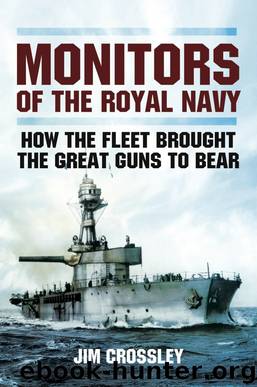Monitors of the Royal Navy by Jim Crossley

Author:Jim Crossley
Language: eng
Format: epub, mobi
ISBN: 9781783830046
Publisher: Pen and Sword
Published: 2013-08-19T16:00:00+00:00
The total cost of these forty ships was thus a little less than the cost of two battleships. It would be difficult to argue that an extra dreadnaught or two swinging at moorings in Scapa Flow, would have contributed as much to the prosecution of the war at sea as did the monitors. The money could of course have been usefully spent on destroyers which cost an average of roughly £250,000 each, so the monitor fleet would have been equivalent in value to about twenty-eight extra destroyers. These would certainly have been a welcome addition to the navy’s strength but a comparatively small one. Britain started the war with 240 destroyers and built 294 during the war. Seventy were lost during the conflict. Had destroyers been built in place of the monitors therefore, the impact on the total strength of the destroyer force would have been marginal, increasing numbers by only about five per cent. On this basis it seems that the monitor fleet gave pretty good value for money.
It is also important to recognise that the enemy was faced by a new and unexpected challenge in the shape of the monitors. This gave Britain a useful surprise factor especially in the actions against enemy raiders in the Channel and in the actions in the Gulf of Trieste and in East Africa. They were a new and unexpected element injected into the war at sea and as such offered the Royal Navy a significant advantage to which the Germans had no easy answer. Their apparent invulnerability to torpedoes and ability to survive mine strikes must have been especially frustrating to submarines and minelayers alike.
The cost of the various classes of monitor also shows clearly what astonishingly good value for money the smaller unnamed ships offered. We have already seen what a vital contribution the river gunboats made to the defence of France in October 1914 and the excellent work done by the small monitors in the Channel and in the Dardanelles. As the table shows their cost was miniscule when set against their achievements.
As well as offering good value, the clumsy, slow, lightly armoured monitors proved surprisingly durable. Only one of the big ships (Raglan) was lost during the war. Of the small monitors only M15, M21, M28 and M30 fell victims to enemy action, not a bad record for a class of ships exposed to more risks than almost any other and designed to be “expendable”. One other ship (Glatton) blew up by accident. Comparison to the destroyer fleet is interesting:
Download
This site does not store any files on its server. We only index and link to content provided by other sites. Please contact the content providers to delete copyright contents if any and email us, we'll remove relevant links or contents immediately.
The Radium Girls by Kate Moore(11592)
100 Deadly Skills by Clint Emerson(4674)
The Templars by Dan Jones(4549)
Rise and Kill First by Ronen Bergman(4538)
The Doomsday Machine by Daniel Ellsberg(4234)
The Rape of Nanking by Iris Chang(4005)
Killing England by Bill O'Reilly(3893)
Hitler in Los Angeles by Steven J. Ross(3790)
Stalin by Stephen Kotkin(3715)
12 Strong by Doug Stanton(3409)
Hitler's Monsters by Eric Kurlander(3148)
Blood and Sand by Alex Von Tunzelmann(3045)
Darkest Hour by Anthony McCarten(3011)
The Code Book by Simon Singh(2840)
The Art of War Visualized by Jessica Hagy(2825)
Hitler's Flying Saucers: A Guide to German Flying Discs of the Second World War by Stevens Henry(2618)
Babylon's Ark by Lawrence Anthony(2422)
The Second World Wars by Victor Davis Hanson(2416)
Tobruk by Peter Fitzsimons(2369)
